Sudovia is a region that is characterized by the most beautiful and authentic Lithuanian dialect. The people here are diligent and generous. The capital of Sudovia, Marijampolė, is a cosy, beautiful and hospitable city, cradle of the Lithuanian spirit that has raised many heroes. Wonderful parks allure to enter, take a seat and enjoy the play of water, colours and light.
Poetry Park. Silently rippling water, romantic paths and bridges, play of light and colours that turns into real performance in dark… There are memorial stone for immortal song of V. Kernagis “Kai sirpsta vyšnios Suvalkijoj…” (When cherries are mellowing in Sudovia…). The beauty is so enormous that may squeeze out the tears…

Park of Vytautas the Great. The beautifully dressed ladies and handsome gentlemen used to gather and relax here in the pre-war times. It is the oldest park of the city that has become even more attractive but still preserves the pre-war spirit. The wonderful demonstrative flowers of Sudovian cultural heritage are planted here. The park is really inviting.

J. Basanavičius Square and monument “To the Nation and Language”. It is the heart of the city and place of all the gatherings that hides history of the past. It is the only Lithuanian monument of this style that tells about road to freedom, history of language and love to the Homeland.

Yard of P. Butlerienė (Cat’s square). She was an extraordinary, strong and influential woman, who succeeded in receiving the first Marian father, founder of Marijampolė, and who loved cats a lot. The cosy and vivid yard in the old town and cats of P. Butlerienė playing with water will tell you, how the history of Marijampolė began. Think of your wish, pat all three cat sculptures and your wish will come true. Near you will see the former synagogue. It is an eclectic building of the historicism period that was built in the city centre in 1870. The synagogue was active until the Second World War; in 1985 the building was reconstructed and adjusted for Marijampolė House of Engineers, and one decade later the Educational Centre of Marijampolė County started working there. They also opened an art gallery of Beatričė Kleizaitė-Vasaris.

The Museum of Ethnography and memorial museum of the President Kazys Grinius. The Museum of Ethnography – one of the oldest museums in Suvalkija. The museum started to work in 1933, it can be found in the former Courthouse. The visitors can see the exhibitions like “Tautos Dvasia” and “Miestas Prie Šešupės”, to get to know the life style of Suvalkiečiai and the history of Marijampolė. Here you can find amazing and unique exhibits: “Turlojiškės žmogaus” a skeleton which is 3000 years old, one of the biggest funeral urns of Lithuania, an impressive sized book of court acts from XIX century, chapel for memorial of uprising in 1863 and many home goods, old coins, written papers and textile.
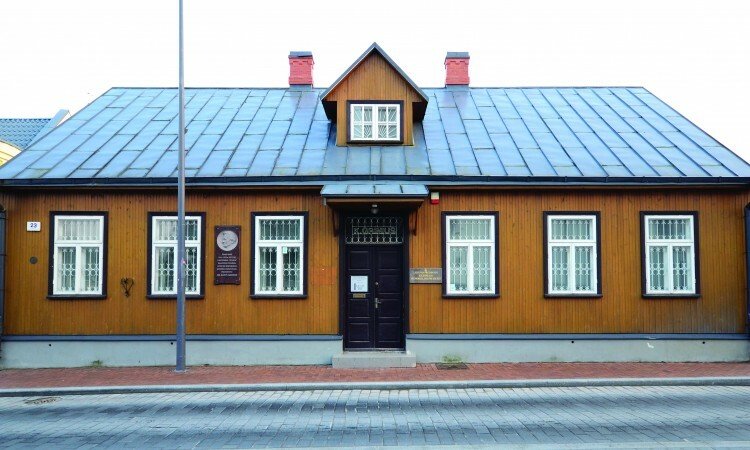
The memorial museum of the President Kazys Grinius stores memories about K. Grinius, who although was a president only for half a year, but achieved much in other areas during his long life. He was not just a Lithuanian politician, but also a doctor, public and cultural actor, humanitarian, one of the first Lithuanian democrats, sexton, educator, publicist, and book smuggler.
The Museum of Partisans of Tauras District. It is considered to be one of the best museums of this type in Lithuania. Its exhibits tell in detail about the partisan movement in Sudovia. The documents about victims and executioners of that bloody period could be found here.

Museum of Old Cars and Motorcycles “Kubilkiemis”. This collection was concluding for a quarter of a century. Here you can find cars and motorcycles from the past. This museum is based in an old bakery building. It has not only cars and motorcycle collections but also exhibits like old tools, utensils and devices. All the transport is older than 30 years and is made in The Soviet Union. There are cars MAZ, Moskvic, GAZ, ZAZ and even a car for disabled people SZD Invalid. The history about each exhibit will be told by the owner of the museum.

Little basilica of St. Michael the Archangel and the Marian monastery. See for yourself what attracts thousands of believers from Lithuania and entire Europe to Marijampolė every year. There are the paths walked by the Venerable Jurgis Matulaitis and Marian fathers, and secrets and history protected by high walls of the church. The Basilica of St. Michael the Archangel is one of the most important churches in Vilkaviškis Diocese. It is famous not only among local believers but also among pilgrims of the neighbouring lands. They come to pray by the remains of the Venerable bishop Jurgis Matulaitis (1871 – 1927). In the Marian monastery is museum of Jurgis Matulaitis. Two expositions are prepared in the museum of the Venerable Jurgis Matulaitis in Marijampolė Marian monastery: the exposition “The White Marians” introduces to the beginning of the city of Marijampolė and history of the Marian monastery, while the exposition “The Venerable Jurgis Matulaitis” reveals active life of the priest, bishop, archbishop, professor, monk, social actor and diplomat Jurgis Matulaitis, his biography and spiritual life.
Marian Monastery. The Lithuanian Marians have rich history. They were especially active in Sudovia and even gave the name to the city of Marijampolė. The Marian monastery was built in 1791 here and has witnessed many events and withstood storms of several generations. Some Marian fathers continue to live in the cells here.
Memorial bench for V. Urmanavičiūtė-Urmana, the nightingale of our land. The bench may fulfil the dreams – all you have to do is sit down on it and wish for something, and all the dreams, graceful as the song of nightingale, will start coming true.
Gymnasium of Rygiškių Jonas. “Lithuania, our dear homeland, land of worthy heroes” – that is the work created by the pupil of this gymnasium. The father of the Lithuanian language, the Lithuanian president and other famous heroes were educated in the gymnasium in Marijampolė. It is still operating and many generations in the future will keep talking about nowadays pupils of the Gymnasium of Rygiškių Jonas, who will leave their significant traces „.

Bukta Hiking Trail. Bukta natural hiking trail is located in the territory of Marijampolė municipality, 6 km south-eastward from Liudvinavas. It has become popular very quickly and welcomes visitors all year around. This trail has turned into perfect place to spend time with the family. The people, who come, often make picnics eating by the fire. The camping place in the middle of woods was arranged in order to meet the tourists’ needs. It is located just 700 metres from the hiking trail and is referred to by signs. It provides perfect possibility to spend time with the family and children in nature, to teach the little ones the names of the trees and to teach them to recognize various plants, mushrooms and berries.

All the things necessary to make a good picnic are present in the camping place – an arbour, a swing, dustbins, and a WC. People may spend their time in different way than usually – special fire place was arranged so that it would be possible to hang a pot, to cook some soup, and to eat it surrounded by trees. People may enjoy the view of nearby pond that is unique, because half of the pond is renewed and enlarged, while the other half was left as a natural swamp in order to preserve nature and ecosystem.
All people, especially botanists and naturalists find Bukta Wood to be unique. It is one of the most valuable woody territories in Lithuania and more than 500 kinds of herbaceous plants may be encountered there. Bukta hiking trail offers a cognitive walk of 1,3 km. On the way, 7 posts are arranged, where people may get familiar with hornbeam forests, alluvium forests, swampy leafy forests, and versatile plants and animals growing and living by the trail.
Malonny: Marijampolė – London – New York

The art works created during the architectural symposia decorate facades of city buildings. The project was started in 2014. It serves not only to create art works on the walls of city’s buildings, but also to organize forums, discussions, workshops under the topics of art, architecture and design, and to present the musical and video performances of the world famous artists.
The Floating World (Ray Bartkus, USA, 2015 Malonny 2)
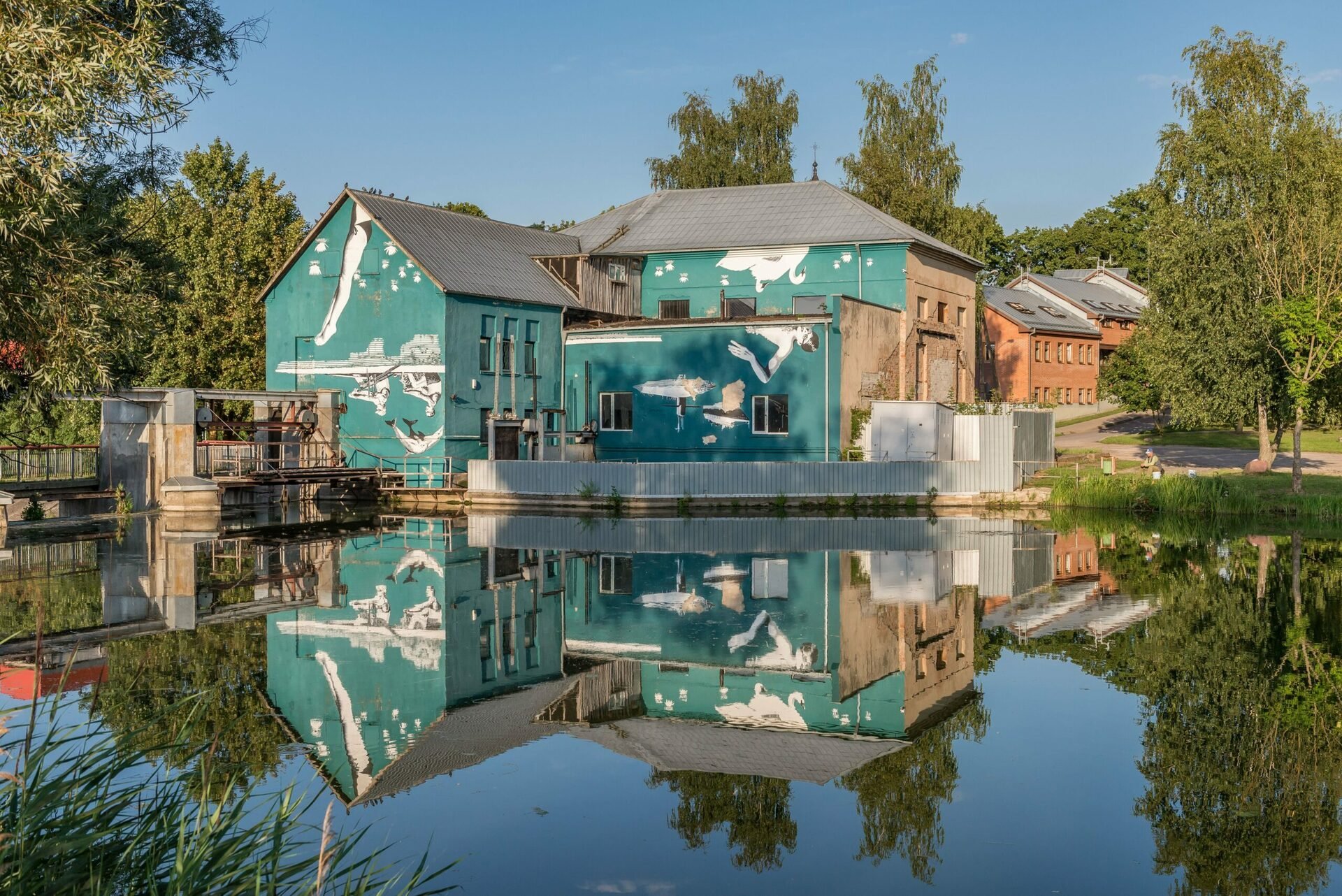
Artist Ray Bartkus created a “Floating World” mural on the wall of the Marijampolė Old Dam building. The mural is drawn upside down, the real perspective can only be seen in the reflection of water. Depending on weather conditions, the reflection is rippled or clear, and sometimes disappears completely. The Artist expects that each time passerby will find something new. This piece of art is like a life – different every time.
Bažnyčios str. 48B, Marijampole
Arctic (Ieva Martinaitytė – Mediodia, USA, 2017 Malonny 4)

This impressive size mural symbolizes the melting of glaciers, changes of the earth due to the impact of human interventions on the planet. In the mural we can see melting water all around and the “android” in the middle – the symbol of the future humanity affected by these changes.
Poetry Park
Submarine (Ray Bartkus, USA, 2016 Malonny 3)
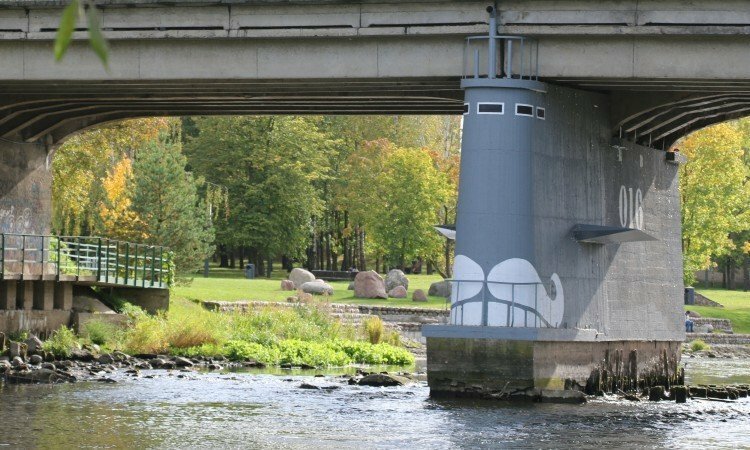
According to the artist – he immediately imagined the submarine instead of the bridge column. In peaceful, calm scenery of the pastoral town, the militaristic object highlights the conflicts of the past in the region, and also warns of future threats. You can find the initials of artist (RB) and the year when mural was done (2016) on the fragments of ship.
Poetry Park
Consumerism (Philip Grisewood, United Kingdom, 2015 Malonny 2)
Philip Grisewood is an illustrator who uses various techniques created by the artist through the years experimenting with different textures and methods of the media. This art work is dedicated to consumerism – the painting is a symbol of fast food, permanently busy lives, not seeing what’s going on around, urban pollution and environmental damage. The English term “VOID” is highlighted as in this mural its’ meaning is emptiness, vacuum, nothing. The place is chosen to symbolize the transition at the gates of a consumer life, to a completely different world – is a bridge to an art oasis, calmness and different culture.
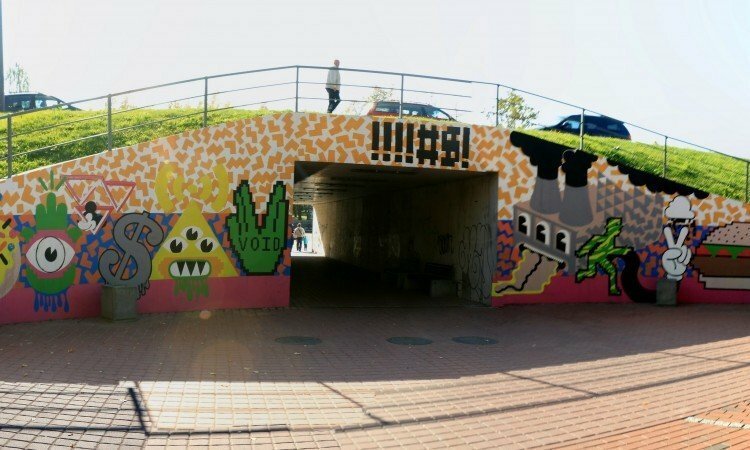
Poetry Park
Landscape of Emotions (Rachel Price Bacon, USA, 2016 Malonny 3)

This wall painting is based on a piece of crumpled paper. Many Tints of grey, black and white match facets in the damaged paper. The pattern resembles a cross-section of granite or other crystalline rock, the starting point is something quite fragile. A crumpled piece of paper is usually thrown away, considered a failure. But often mistakes can open up new pathways. The “wrong” way may turn out to be much more interesting than the original, intended destination. The damage done to a piece of paper is irreversible, therefore it’s impossible to make it smooth again once it’s been crumpled. Similarly, other forms of damage, psychological, historical or geological, may also be impossible to repair; they remain hidden while at the same time giving shape to the visible landscape.
Laisvės str., Marijampole
St. George and The King of Ethiopia (Eli Elysee, USA, 2016 Malonny 3)

Saint George slaying the dragon, a reinterpreted Christian legend, is an iconography that is recognized throughout the City of Marijampole. This same symbol has been used by Rastafarian artist Neville Garrick depicting Reggae legend Bob Marley as an Ethiopian St. George. This apparent metaphor for good conquering evil is shared from Lithuania to Ethiopia and Jamaica. Additionally, the Rastafarian movement uses the Ethiopian flag’s color sequences as their own color symbols. Interestingly the same flag colors, albeit different color sequence is that of Lithuania’s. It is these coincidental elements that brought forth the conversation depicted by Elysée’s mural.
Laisvės str. 30, Marijampole
iCave Paintings (Michael Kevin Estabrook, USA, 2015 Malonny 2)

These three different murals show us the main problem and trend at the moment. People see the world through their smart devices, where reality is reflected through video cameras attached to their heads. The author encourage us to start making changes in our life.
Laisvės str. 28C, Marijampole
Live For Now, Die For Later (Vandana Jain, USA, 2015 Malonny 2)

The painting is like a language made up from different logotypes. The phrase on the left – “Live for Now, Die for Later” is the main statement of this painting. Vandana wanted to create something different, which would force everyone to stop and think about life. The contrast of death and life creates very strong feelings. You can also see hands, holding the drop of water, which is also the symbol of life.
P. Butlerienės skg., Marijampole
Pizza Umbrella (The Bubble process: Sean Higgins and Nicholas Rezabek, USA, 2014 Malonny 1)
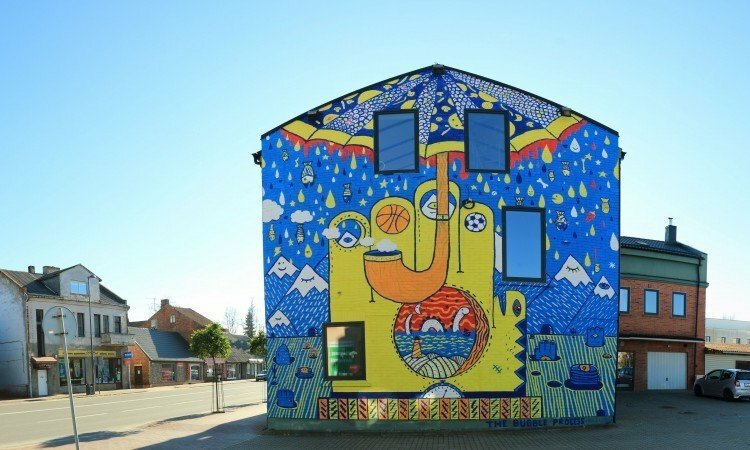
The initial approach was to utilize the building’s shape when developing the artist concept . They had a lot of fun sketching potential ideas, and ultimately landed on an umbrella raining from inside. The umbrella is made of the artists’ favorite food, Pizza. The portal takes them back to their home State of Ohio, and provides a look at the local sea monster “Bessie”, who lives in Lake Erie. The Mountains are there to keep a an eye on the land below and provide some nice scenery for the wonderful people of Marijampole.
V. Kudirkos str. 20, Marijampole
The Wall of Cats (Meg Regelous, USA, 2017 Malonny 4)

M. Ragelous’s works can be characterized by magnifying small and individual details, which at the end creates fascinating view. However, she changed her idea after seeing Marijampolė and hearing the story about the square of cats. Before hearing the story, she imagined some kind of mystic characters on the wall, but afterwards she drew cats and birds to depict fragments of the history of Marijampolė and the Countess Butlerienė love for cats.
P. Butlerienės cat‘s square, Marijampole
The Flying Birds (Eli Elysee, USA, 2015 Malonny 2)
The metal birds are waiting for a sunny day while hanging out on top of the fence. You can see shadows as the sun reaches them and creates an illusion that they are actually hanging on the branch.
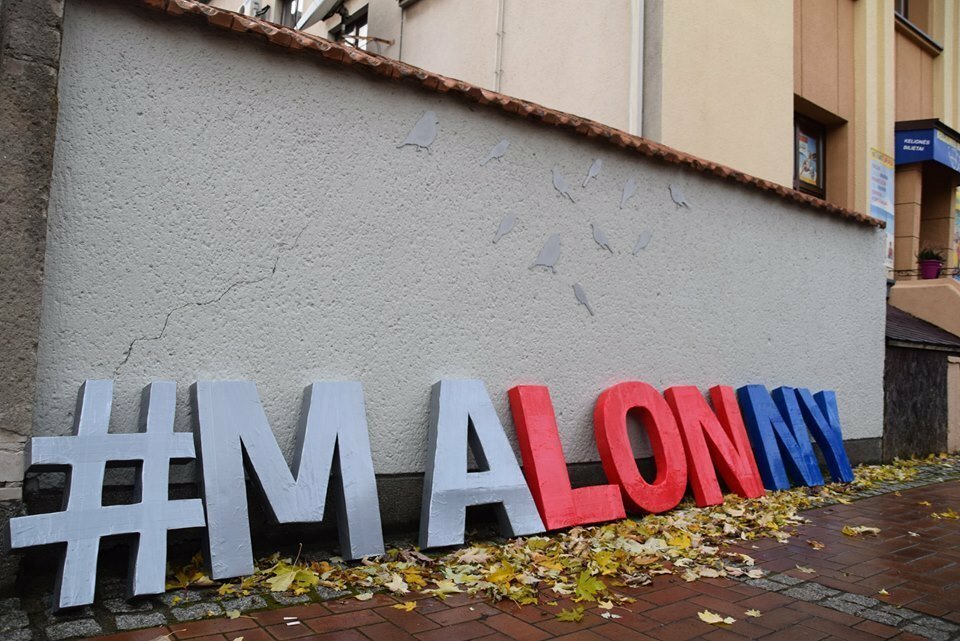
Kęstučio str., Marijampole
Light Installation in the City Center (Kacper Dolatowski, Ray Bartkus, USA, 2016 Malonny 3)

The artist Ray Bartkus and light designer Kacper Dolatowski from New York, created an innovative lighting installation, that enriches and animates J. Basanavičius square in the center of Marijampolė. This work not only enhances events taking place here, but also creates a unique atmosphere in the evening.
J. Basanavičiaus square, Marijampole
Bus Stop (Ray Bartkus, USA, 2017 Malonny 4)

On the right side of the wall the artist depicted his remarkable assistants from Marijampole, without whose help he would never been able to finish the mural. The left side of the wall is dedicated to famous US Singer-songwriter Bob Dylan, riding a motorcycle. In the middle of the wall sitting on a bench and waiting for the bus to Vilkaviskis is another world famous singer-songwriter Leonard Cohen. Both Dylan’s and Cohen’s family roots reach back to this part of the world, called Suvalkija. The alien playing cello is settled here from another beloved mural by Ray Bartkus “Alien Symphony” created during “Malonny 1” and unfortunately destroyed.
J. Basanavičiaus square 3, Marijampole
Flock of doves (Will Teather, United Kingdom, 2018 Malonny 5)
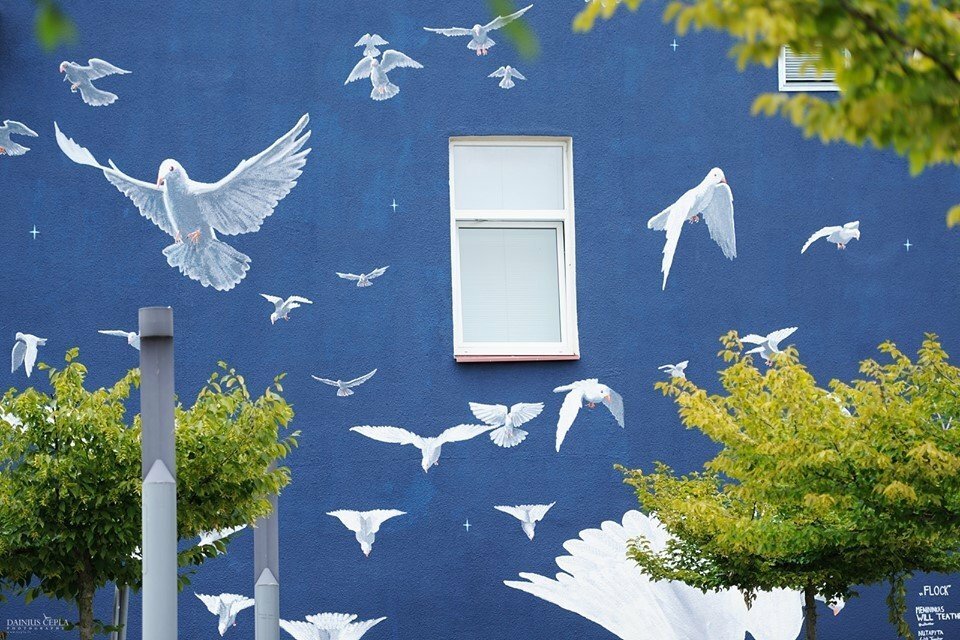
Will Teather is internationally known for creating artworks that are both refreshingly contemporary, otherworldly and rooted in the medium’s rich and complex traditions. “Flock” is intended to depict an impossible viewpoint, as if the viewer is stood in the middle of a flock of birds. The composition creates an immersive experience for the viewer through both the perspective and scale of the composition. The artist has always been drawn to the sense of spectacle associated with birds and their inherent symbolism, with doves being a symbol of peace.
P. Butlerienės cat‘s square, Marijampole
Anonymity of the crowd (Jeff Woodbury, USA, 2018 Malonny 5)

In a crowd, we become invisible. We are free to expose our true nature without fear. This can be profoundly and creatively liberating. It can also conceal, and reveal, darker natures.
P. Butlerienės cat‘s square, Marijampole
Landscape of Emotions (Rachel Price Bacon, USA, 2018 Malonny 5)

This wall painting is based on a piece of crumpled paper. Many Tints of grey, black and white match facets in the damaged paper. The pattern resembles a cross-section of granite or other crystalline rock, the starting point is something quite fragile. A crumpled piece of paper is usually thrown away, considered a failure. But often mistakes can open up new pathways. The “wrong” way may turn out to be much more interesting than the original, intended destination. The damage done to a piece of paper is irreversible, therefore it’s impossible to make it smooth again once it’s been crumpled. Similarly, other forms of damage, psychological, historical or geological, may also be impossible to repair; they remain hidden while at the same time giving shape to the visible landscape.
J. Basanavičiaus square, Marijampolė
Do what you can’t (Ignas Vieversys, Lithuania, 2018 Malonny 5)
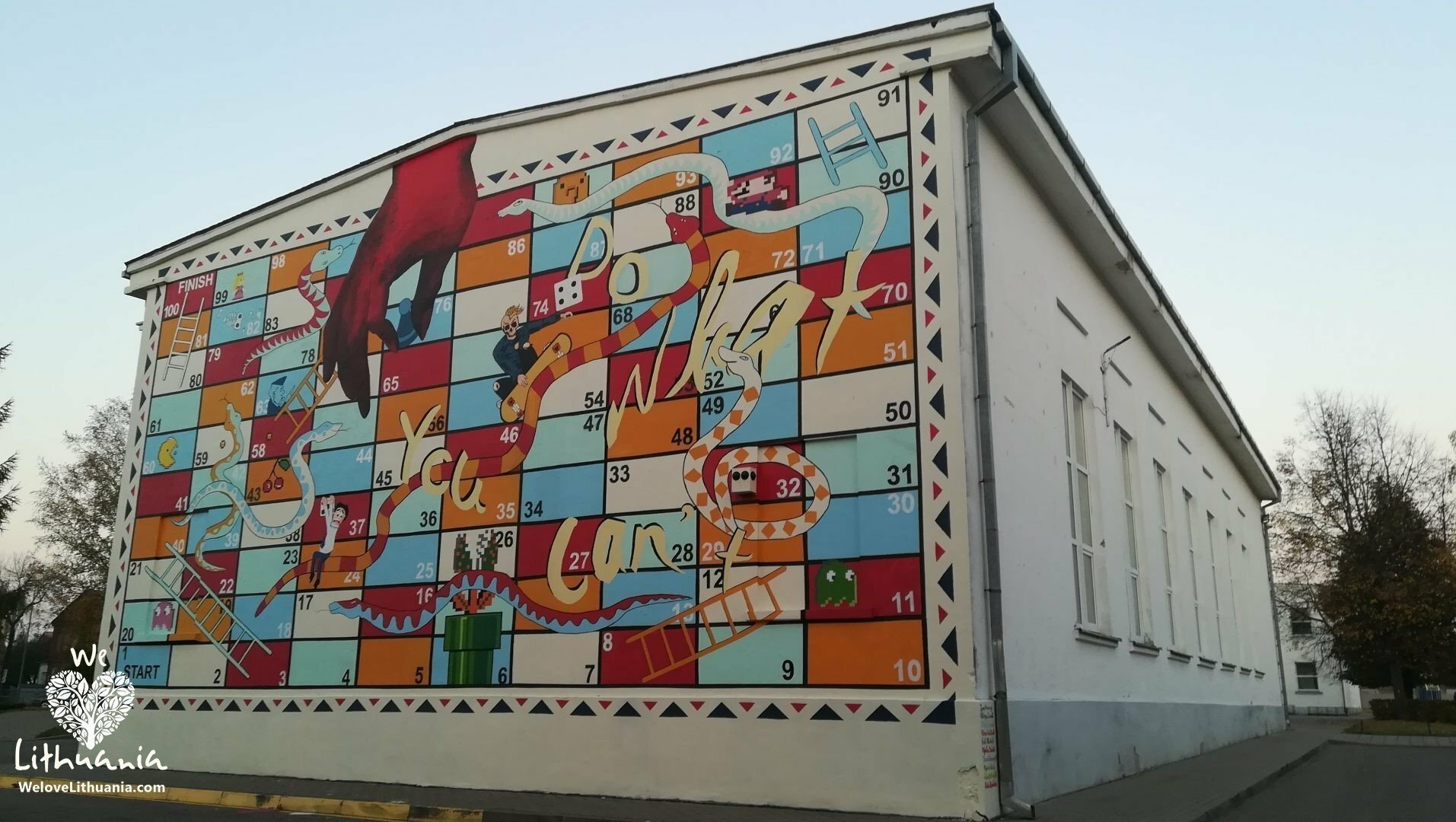
This palyboard symbolizes a well-known play “Snakeladder”. The drawing has been improved with the details of computer games and many other items inviting to break the rules of the game. The drawing depicts the hereos of the play who are the symbols of two different sides of the behaviour: a good and a bad one. A little person hanging on a dice and playing according to the rules of the game, loses. Wherereas, a skeleton, breaking the rules of the game, rises upwards till the end of the game. Namely this understanding symbolizes the title of the game “Do what you can’t”. The picture is drawn on the wall of a school building and depicts the idea of contemporary often riotuos youth which constatntly breaks the rules and does what is not allowed.
Vasario 16-osios str. 7, Marijampolė
Crowd Surfing (Ianthe Jackson, USA, 2018 Malonny 5)

The mural Crowd Surfing references an animation work I made. In making animation I am always thinking about how movements are made. I began to trace the paper puppets to study the movements of the puppets and the drawings resemble the drawing you see in this mural. When people are crowd surfing they pop up from the crowd and are carried by the crowd and fall back into the crowd. Their movement in the crowd and being carried by the crowd is a metaphor for aspects of our life as social beings.
P. Butlerienės str. 18, Marijampolė
Ceci n’est pas un mur (Ray Bartkus, USA, 2018 Malonny 5)

Famous Belgium surrealist Rene Magritte made a drawing of his pipe and wrote the title “Ceci n’est pas une pipe” (eng. This is not a pipe) below the image. He wanted to emphasize that the viewer is seeing not a real pipe, just a painted illusion created on the paper. Ray Barkus turns this logic upside down. By painting the sky on the wall and naming it “Ceci n’est pas un mur” (eng. This is not a wall), he claims that the imagination is capable of creating a new reality.
P. Butlerienės str. 9, Marijampolė
Stairway to heaven (Ray Bartkus, USA, 2019 Malonny 6)

Ray Bartkus creates surreal distorted reality by adding painted stairways and other spatial architectural elements to the existing stairway and the wall. The artist questions the perception of reality. Mental imagery and visualization can alter how we perceive the world around us. To a large extent, the mind creates reality.
Laisvės str., Marijampolė
Pills (Eli Elysee, USA, 2019 Malonny 6)
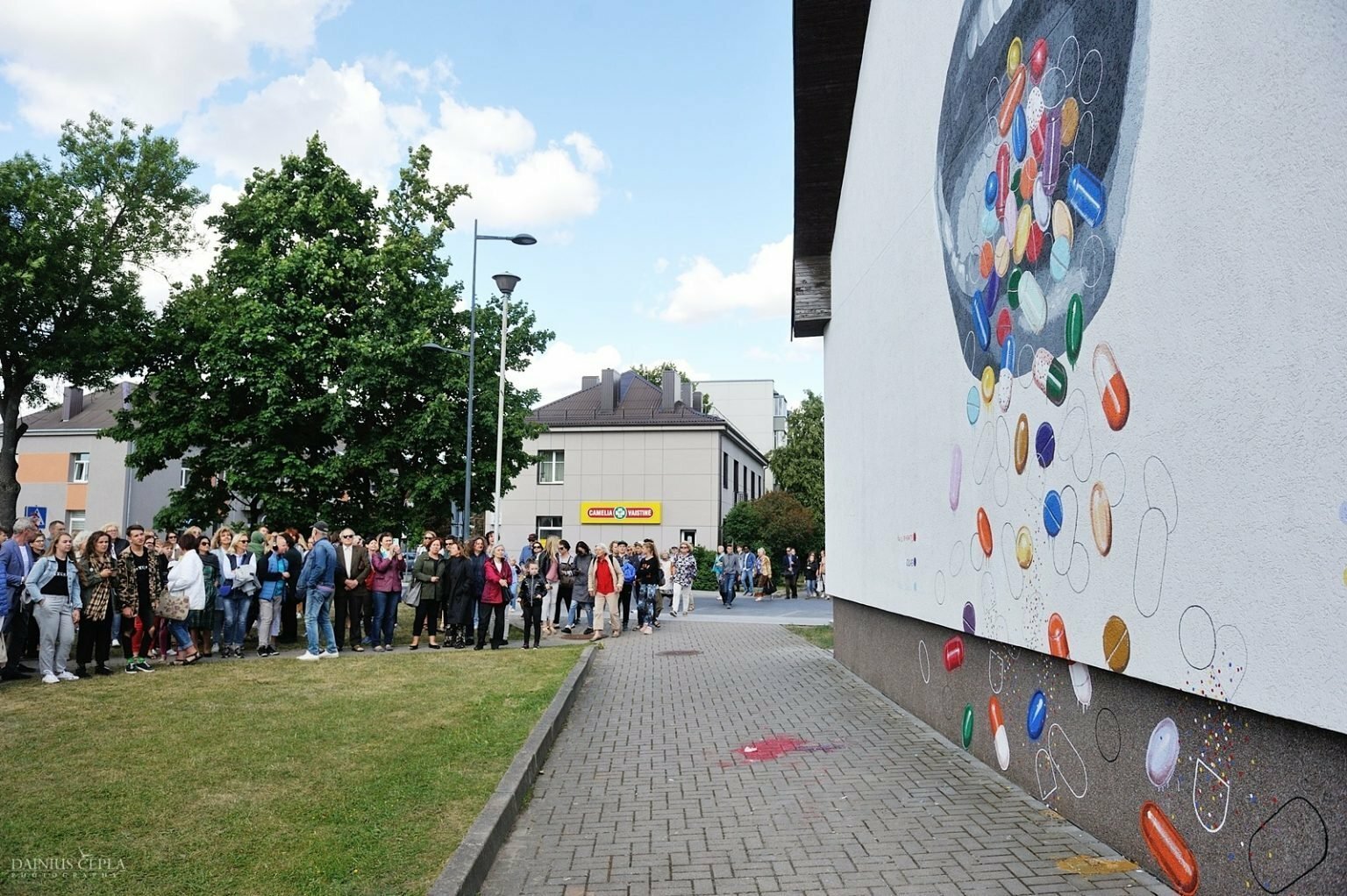
The wall location at hospital site seems fitting for an image that reflects the ever-present dilemma of necessary medication, our dependency on medication, and/or our over-indulgence of medication. Nothing suggests our vulnerability and self-expression more so than an open mouth. Eat, drink, swallow, yawn, breathe, a scream, expressing awe and opening wide to a doctor’s request covers it all. The two images fused together in a symbolic way capture our nakedness and the fact that we’re not totally shielded and in total control from the external element.
Kriaučiūno str. 2, Marijampolė
IN.side.OUT (Radvilė Krušnauskaitė, Lithuania, 2019 Malonny 6)

IN.side. OUT drawing depicts school, as school for every child is a place where he/she is separated from a family and creates his/her own picture of his/her individuality to the outside world. Also, the picture reveals the aspects of bullying. A lot of people see only the outside picture because, in many cases, eyes cannot reach heart and can see neither a fragile soul of an artist nor the “IN” mistakes of a personality. All life consists of tiny and diverse details but every single detail (sometimes it is hurting or even not understandable at first), is necessary because it is a common part of a picture. What each person sees depends on his/her attitude: if he/she sees a white detail or space for imagination, creativity or cosmos. IN.side.OUT drawing depicts the fact that every person is one who destroys, builds walls and makes heart nude, he can be in the side of IN or OUT.
Vasario 16-osios str. 7, Marijampolė
P.Š.B. (Ray Bartkus, USA, 2019 Malonny 6)

Painting of the cat is inspired by the history which dates back to 1750, the year when the local Countess Pranciška Ščiukaitė-Butlerienė ordered the church to be built around which the City Of Marijampole grew. According to the local folklore, the Countess was very fond of the cats and took care of many. That’s why so many images of the cats adore the City of Marijampole, this being only one of many. The painting is done by the handprints of many volunteers, who can refuse to pet a soft kitty?
J. Basanavičiaus square 8, Marijampolė
